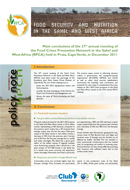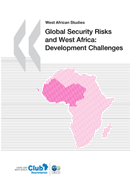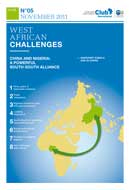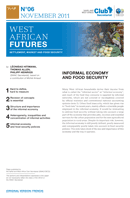SWAC Publications
Recent Publications
|
|
RPCA Policy Note, no. 5, January 2012
The Food Crisis Prevention Network (RPCA) Policy Note summarises the main conclusions of the network’s 27th annual meeting which was held from 8 to 10 December 2011 in Praia. The meeting brought together key food security actors who jointly prepared an assessment of the 2011-2012 agropastoral season and food prospects. They also considered the state of progress of the Charter for Food Crisis Prevention and Management, and discussed the issue of “food processing and food security”; the development of the food processing industry still poses tremendous challenges. Recommendations for next steps in each area target governments, regional organisations, and West Africa’s technical and financial partners. |
|
|
|
|
|
Global Security Risks and West Africa: Development Challenges OECD West African Studies, January 2012 This SWAC publication explores current global security issues, their development in West Africa and their potential impact on regional stability. It takes a close look at issues such as terrorism and trafficking, climate change, and the links between “security and development”. Some of these issues are still the object of heated debate. This book draws attention to the risk of oversimplified analyses and biased perceptions of security risks. It also highlights the need for co-ordinated policies and dialogue between West Africa, North Africa and OECD countries. |
|
|
|
|
|
China and Nigeria: a powerful South-South alliance
West African Challenges, no. 5, November 2011 Margaret Egbula, Qi Zheng |
|
|
|
|
|
Are economic free zones good for development?
West African Challenges, no. 4, November 2011 François Bost, Geographer, Senior Lecturer at Université de Paris-Ouest-Nanterre- La Défense |
|
|
|
|
|
Informal economy and food security
West African Futures, no. 6, November 2011 It would be misleading to address food security without taking into account a large part of the economy that provides jobs, income and essential services for the urban population and for the non-agricultural population in rural areas. Despite its important role, however, the informal economy is still poorly defined, poorly measured and consequently, poorly incorporated into food security policies. This note assesses the overall size and importance of the informal economy in the West African region and takes a closer look at the way it operates. |
|
|
|
|
|
Emerging good practice in combating the worst forms of child labour in West African cocoa growing communities
November 2011 Building on work conducted by the SWAC Secretariat in collaboration with the International Cocoa Initiative, this guidebook gathers together experiences and ideas from representatives of governments, organisations and agencies active at different stages along the cocoa supply chain as well as from men, women and children living in cocoa growing communities. It outlines seven key recommendations and identifies some emerging good practices from existing interventions in the hope of contributing to their wider application. It reflects on the different roles and responsibilities of key actors in order to encourage greater clarity, co-ordination and collaboration in the coming years. |
Related Documents







